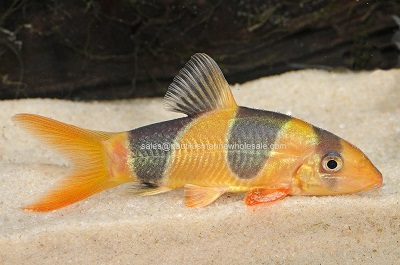
Product Details
Clown Loach ( Chromobotia macracanthus)
A very popular fish with vivid coloration, this fish is often purchased to rid a tank of snails. Clown loaches grow to a large size and are social fish that will form a hierarchy led by the largest female. They should be given an appropriately sized tank for a community to thrive and smaller loaches can be used to clear smaller tanks of a snail infestation. Also, clown loaches will often lay on their side or back while resting or sleeping and this behavior should be viewed as normal.
Grows to: Up to 16", usually smaller in aquariums
Hobbyist Level: A fish suitable for aquarists with some experience.
How Many? They are best kept in groups of 5 or more but a large enough tank should be provided.
Housing: Clown loaches are extremely sensitive to poor water quality and frequent water changes are often required. Provide plenty of swimming room as well as some bushy plants for hiding and other fish to make them feel more comfortable. They prefer thick vegetation but may nibble on aquarium plants. They swim in the bottom region of the tank and prefer soft substrate with numerous hiding spots. They enjoy a strong water current that mimics the moving waters they come from. Minimum tank size is about 20 gallons for juveniles and 75 for adults. (Temperature- 74-86), (pH
5.0-8.0)
Tank mates: They are peaceful loaches and should be housed with other peaceful fish of similar size who will not harass them. They may school with Corydoras catfish. They should not be housed with rift lake cichlids.
Feeding: They will accept a variety of foods but their focus is on meaty foods. Feed shrimp pellets, along with blood worms, brine shrimp and frozen foods. They are an omnivore and may nibble on aquarium plants. Clown loaches will eat small snails and snail eggs.
Natural Habitat: Indonesia, Borneo, Sumatra.
Males and Females: Females may appear slightly plumper when full of eggs as well as having the tips of their tails straight. Males will show tips of their tail that curve inwards.
Availablity at Elmer's: We usually have these fish in stock.
A very popular fish with vivid coloration, this fish is often purchased to rid a tank of snails. Clown loaches grow to a large size and are social fish that will form a hierarchy led by the largest female. They should be given an appropriately sized tank for a community to thrive and smaller loaches can be used to clear smaller tanks of a snail infestation. Also, clown loaches will often lay on their side or back while resting or sleeping and this behavior should be viewed as normal.
Grows to: Up to 16", usually smaller in aquariums
Hobbyist Level: A fish suitable for aquarists with some experience.
How Many? They are best kept in groups of 5 or more but a large enough tank should be provided.
Housing: Clown loaches are extremely sensitive to poor water quality and frequent water changes are often required. Provide plenty of swimming room as well as some bushy plants for hiding and other fish to make them feel more comfortable. They prefer thick vegetation but may nibble on aquarium plants. They swim in the bottom region of the tank and prefer soft substrate with numerous hiding spots. They enjoy a strong water current that mimics the moving waters they come from. Minimum tank size is about 20 gallons for juveniles and 75 for adults. (Temperature- 74-86), (pH
5.0-8.0)
Tank mates: They are peaceful loaches and should be housed with other peaceful fish of similar size who will not harass them. They may school with Corydoras catfish. They should not be housed with rift lake cichlids.
Feeding: They will accept a variety of foods but their focus is on meaty foods. Feed shrimp pellets, along with blood worms, brine shrimp and frozen foods. They are an omnivore and may nibble on aquarium plants. Clown loaches will eat small snails and snail eggs.
Natural Habitat: Indonesia, Borneo, Sumatra.
Males and Females: Females may appear slightly plumper when full of eggs as well as having the tips of their tails straight. Males will show tips of their tail that curve inwards.
Availablity at Elmer's: We usually have these fish in stock.
| Product PDF: | |
|---|---|
| Extra Details: |

